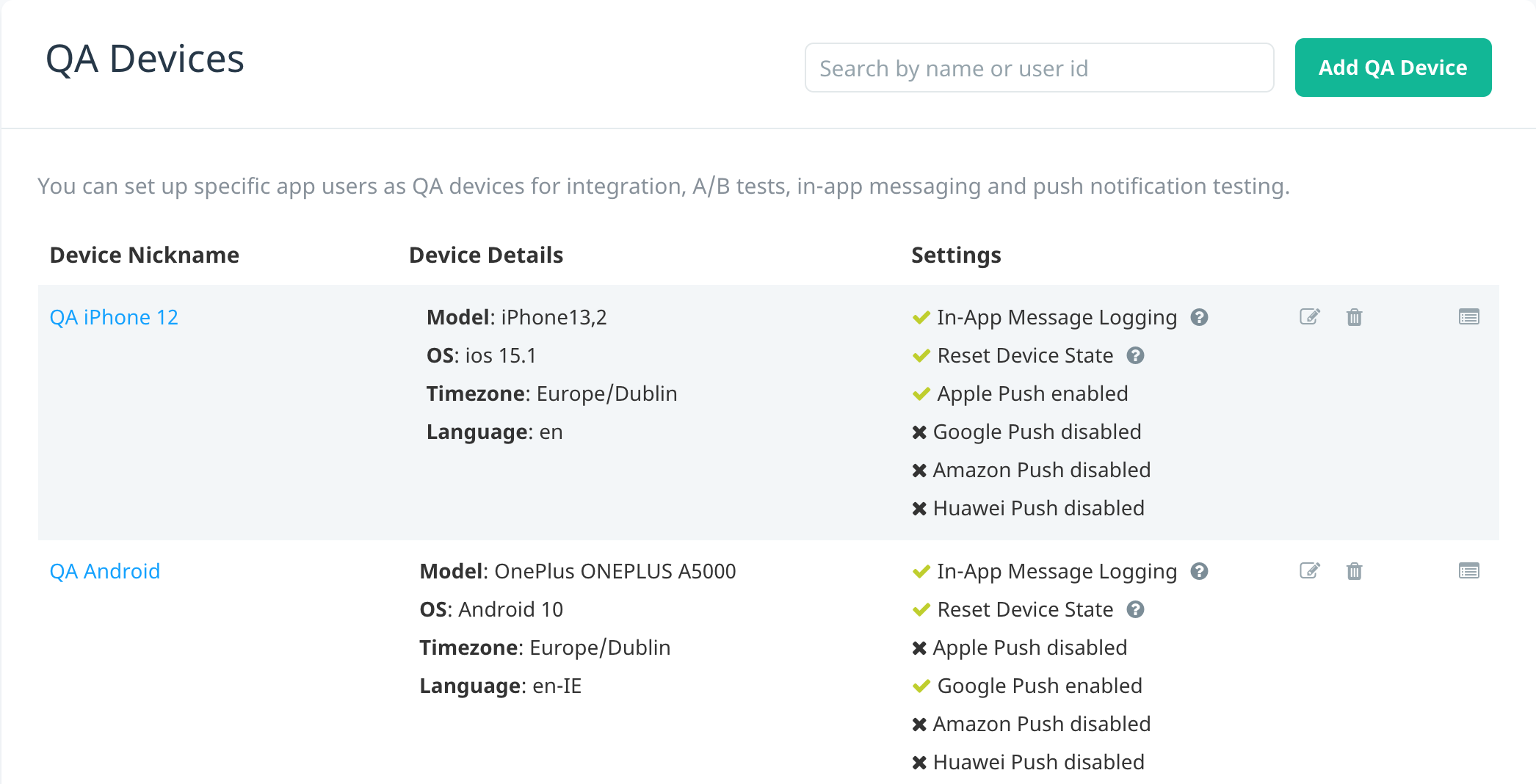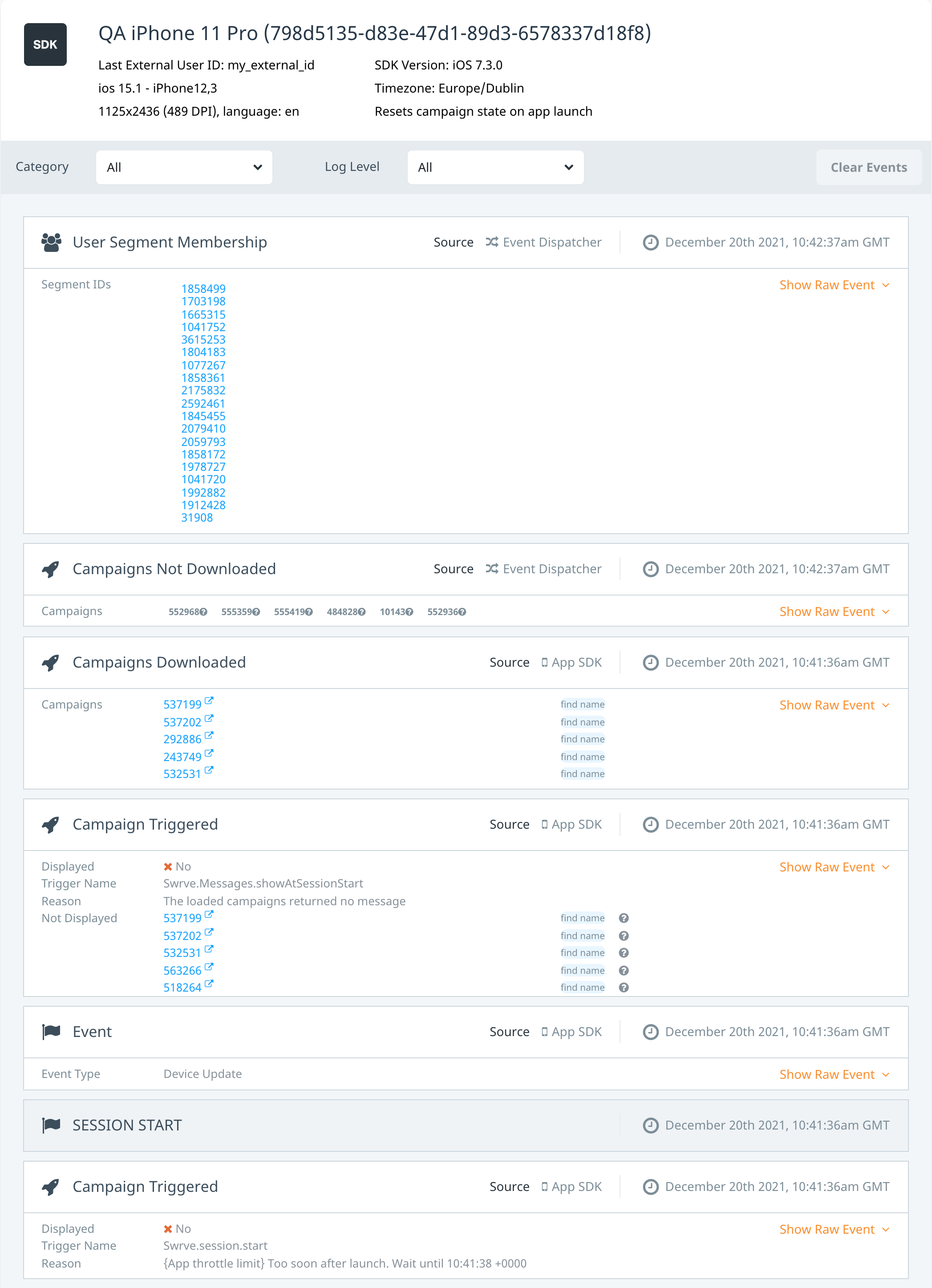How do I set up QA devices?
To QA test your integration, A/B tests, and campaigns, you must first set up the QA devices you want to use for testing. Manage your QA devices and access device event logs with the QA Devices screen.
Set up QA devices
To access the QA Devices screen and set up a new QA device:
- On the Settings menu, select QA devices.
- On the QA Devices screen, select Add QA Device.
- The actions you take in the Add QA Device dialog box depend on the number of the app’s Daily Active Users (DAU):
- If the app has less than 700 DAU, open the app on your device and select Yes, I have opened the app.
- If the app has greater than 700 DAU, enter the device’s Ip address to filter devices relevant to your app. (You can get the IP address by going to www.whatIsMyIPaddress.com in the device’s web browser.) Enter the device’s IP address and then select Yes, I have opened the app.
The dialog box lists the devices most recently seen by Swrve. To refresh the list, select Refresh List.
- If your QA device appears in the list of devices, perform the actions below to select the device. Otherwise, proceed to Step 5 to add the device manually.
- Select Select to the right of your QA device.
- In the Nickname field, enter the nickname that you want to assign to the QA device.
- Select Add QA Device to add the QA device to the list of devices on the QA Devices screen.
- Proceed to Step 6.
- To add the device manually:
- In the Add QA Device dialog box, select add your device manually.
- In the Device nickname field, enter the nickname that you want to assign to the QA device.
- In the User id field, enter the user identifier. Consult your development team about the user ID to enter. The Finding the User ID section at the bottom of this article provides guidelines on how your development team can determine the user ID.
- Select Add QA Device to add the QA device to the list of devices on the QA Devices screen.
- Select Edit to the right of your new device and update the following controls as needed:
- Logging enabled – select this check box if you want the Swrve service to display logging information for in-app messages.
- Reset device state – select this check box if you want to bypass in-app message delivery limits.
- Select Update to save your changes.
The Settings column displays additional (non-editable) controls to inform you whether or not push notification testing is enabled for the QA device in question:
- Apple Push enabled – indicates push notification testing is enabled for the iOS device (a session has been started on the device and the device token has been saved in the database). The QA device is automatically available for iOS push notification testing on the Preview & Test screen of the push notification workflow.
- Google Push enabled – indicates push notification testing is enabled for the Android device (a session has been started on the device and the Sender ID was configured for the device in the SDK). The QA device is automatically available for Android push notification testing on the Preview & Test screen of the push notification workflow.
- Apple Push disabled or Google Push disabled – indicates the iOS or Android QA device cannot currently be used to test push notifications.
For more information about QA testing campaigns and A/B tests, see the following articles:
- QA testing push notifications
- QA testing triggered campaigns (in-app message and embedded campaigns)
- QA testing A/B Tests
View QA user logging
Once you have set up a QA device, you can access event logs for that device. To access the QA User Logging screen and view events for a specific device, select Logging to the right of the device.
The QA User Logging screen displays the following information:
- All events (in real time) sent from the SDK to Swrve, including:
- Original source – Displays the event progression through the Swrve system to show where an error may have occurred.
- The event name and type.
- In some instances, the time of the event.
- Raw JSON data for the event.
- Campaigns triggered and any errors encountered.
- Campaigns downloaded and any errors encountered.
- User Segment logs that display details for all segments a user belongs to.
- Confirmation of the current progress of certain events from the SDK through to the Swrve servers, as indicated by a green check mark.
You can filter the list of events by Category or Log Level.
Troubleshooting QA devices
This section provides recommendations for troubleshooting issues related to setting up QA devices.
QA devices not available for push notification testing
If your development team has integrated push notifications for your app and you have set up QA devices for testing, but your QA device still does not appear on the Test list on the push notification Content screen, check the following:
- Check that your development team are using the most recent version of the Swrve SDK. The minimum SDK versions that support push notifications are iOS v2.7 and Android and Unity v2.9.
- For iOS QA devices, check that the Apple Push enabled control appears for the device. For Android QA devices, check that the Google Push enabled control appears for the device. If either control is disabled, it is likely your development team have not performed the required configuration. For more information about the technical prerequisites for push notifications, see Intro to push notifications.
Finding the user ID
To determine the user ID for a specific device, your development team can use the methods outlined below for iOS, Android or Unity, depending on the platform of your app. Alternatively, they can use Wireshark to find the user ID for any platform.
iOS
- Connect the iOS device to your machine.
- Open Xcode and navigate to Window > Organizer > Device > Console.
- Restart the app on your device. An entry is now available which contains information such as the user ID, app ID, API key and other SDK configuration information.
Android
By default, the user ID of your device is the Android ID. Access this ID by using an app from the Google Play store.
Unity
By default, the user ID is the SystemInfo.deviceUniqueIdentifier for your app.
Wireshark
You can use Wireshark to determine the user ID for any platform. The device must be on the same network as the device capturing the packets.
- Start Wireshark.
- Select Capture > Start.
- Restart the app on your device. An HTTP request to http://<app_id>.api.swrve.com is now displayed with the user ID (or http://<app_id>.eu-api.swrve.com if your app is configured to use Swrve’s EU stack endpoints) .

